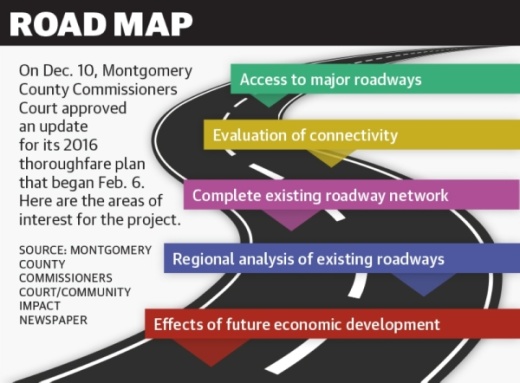The plan, which will be conducted by The Woodlands-based firm Brown & Gay Engineers, identifies the county’s transportation needs, but it does not specify how these projects will be funded, Montgomery County Judge Mark Keough said.
“While not every road on the thoroughfare plan will come to fruition, an updated plan will act as a guide to the court when we are addressing future infrastructure projects,” Keough said.
Possible funding opportunities could include a new countywide mobility bond, officials said.
As officials are still working to identify specific projects in the updated thoroughfare plan, a report released in August by the Texas A&M Transportation Institute of the 1,854 most congested roads in Texas identified several congested corridors in the Conroe and Montgomery area that rank in the top 1,000, including Hwy. 105 West, East Davis Street and North Loop 336.
Need for an update
Montgomery County’s rapid growth has created a need to review the thoroughfare plan often, and the plan is a wish list for the needs of the county, Precinct 1 Commissioner Mike Meador said.
Keough said the thoroughfares are needed to move residents from neighborhoods to the state road and highway networks.
Meador and Precinct 1 Engineer Michael Beitler said the county’s most significant needs are in south Montgomery County. They said Precinct 1 does not have any major infrastructure needs—despite the Texas A&M Transportation Institute’s research.
However, Keough said the county overall needs to address its growing infrastructure needs amid its growing population and development.
In the past several years, the county has seen the addition of thousands drivers annually. According to the U.S. Census Bureau’s five-year American Community Survey estimates, more than 224,003 residents in Montgomery County drove alone to work in 2018.
Although the BGE’s thoroughfare update is still in the works, several roads in the Lake Conroe area have been identified among the most congested in the state by the Texas A&M Transportation Institute study. The study determines the average travel speed with and without congestion, the average amount of drivers, and how much gas and time is wasted while sitting in traffic.
The highest-ranked road in the Lake Conroe area is the portion of Hwy. 105 from I-45 to McCaleb Road, which ranks No. 474 statewide. According to the study, the annual cost of congestion for that portion of the road is almost $10.2 million.
Because this road is maintained by the state, the Texas Department of Transportation is in charge of any improvements to Hwy. 105 and the other four roads. Although each of the five most congested roads in the Lake Conroe area has projects ongoing or planned for to improve access to the roads or add lanes, it is unclear how these projects might coincide with the thoroughfare plan. TxDOT Public Information Officer Emily Black did not respond to requests for an interview.
Lake Conroe-area residents have voiced their concerns for transportation in the area, such as April Sound resident Wanda Henry-Ruthstrom, who said she grew up on Hwy. 105 and has seen traffic along the road get worse.
“It seems like there is a mass of people coming from Conroe to the lake area via [Hwy.] 105 at rush hour times, and the current roads/lights just aren’t handling it,” Henry-Ruthstrom said.
Need for a bond
Meador said since he came to office in 1993, transportation and mobility in the county have changed dramatically, from dirt roads to major roadways.
The county has since called for several mobility bonds, the most recent in 2015. Of the $280 million approved in the 2015 bond, each of the precincts has between $9.4 million and about $68.7 million leftover of the funds originally provided to them.
One project in Precinct 1 still underway is the expansion of FM 1097 from two lanes to four, which has been part of Meador’s work since 2005, he said. Although it does not rank on the transportation institute’s report, four segments of the road are projects from the 2015 bond. In total, these projects will cost roughly $17 million and be completed by September 2021.
Lake Conroe-area resident Donna Smith-Tuter said she and her family have lived on FM 1097 for generations and have seen the traffic grow more dangerous over the years.
“Now the road is overcrowded, and everyone drives way too fast,” Smith-Tuter said.
After Precinct 1 has completed ongoing projects from the 2015 bond, there will be about $150,000 leftover from the funds initially allocated by the bond. Meador, who is not running for re-election, said the next commissioner can decide whether to buy down bond debt or invest in other mobility projects, pointing to wood bridges throughout the precinct that may not meet TxDOT standards.
Meador’s office did not respond to requests for specific roads that the precinct would now focus on.
Keough said the discussion for a new bond will come up later in 2020 or early 2021, after the thoroughfare planning is complete. But as the county grows, he said it will need a combination of state and federal dollars with local matching funds for the projects needed.
“When projects are identified and the court agrees to which are priorities, we will begin to work with our community stakeholders and citizens to receive input and refine our list of projects,” Keough said.






